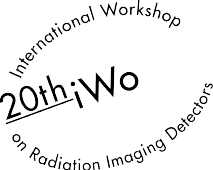Speaker
Description
The interest in proton therapy is increasing worldwide thanks to its unique dose delivery characteristics, which can deliver conformal dose distributions to target volumes while minimizing damage to normal tissue. However, the proton therapy has a quite important issue for the treatment verification; in vivo real-time proton beam range verification. As the representative in vivo range verification systems, there are prompt-gamma (PG) imaging system and positron emission tomography (PET) system. The PG imaging system has high accuracy for measurement of the proton beam range, while the sensitivity is low. The PET system is able to estimate three-dimensional (3-D) dose distribution, while the accuracy of range determination is low. Therefore, we proposed a PG-PET system that combines the advantages of the two systems and optimized the PG-PET system using Monte Carlo method (figure 1).
The PG-PET system was designed in Geant4.10.00 with a 2-D scintillator array, two silicon photomultiplier (SiPM) arrays for a dual-ended system, and a parallel-hole collimator covering 64 x 64 mm2 area. The geometry of the collimator and the scintillator array, scintillation material, energy window (EW), and time-of-flight (TOF) window were optimized based on the radiation field generated by the interaction between 150 MeV proton beam and 30 x 20 x 20 cm3 water phantom. As an additional background-reduction technique, a depth-of-interaction technique (DOI) was proposed and assessed.
As a result of the optimization study based on the sensitivity of the system and the capability of measuring proton range, the thickness, the pitch and the hole sizes of the collimator were 200 mm, 8 mm, and 7 mm, respectively. The thickness and the pitch size of crystal bar were 30 mm and 4 mm, respectively. The LaBr3 and GAGG scintillator showed good performance considering light yield of the crystal and a figure-of-merit that we made in this study. Among 12 energy windows, 3-5 MeV energy window was taken to be the optimal energy window reducing the portion of background radiation 14.88% compared to the not applied case. In the case applied DOI and TOF techniques, the background was reduced by 17.38% and 57.36%, respectively.
In this study, we present the capability of proton beam range verification according to the change of geometrical parameters of the PG-PET system and background reduction techniques and offer the possibility of integrating PG imaging system and PET system.




